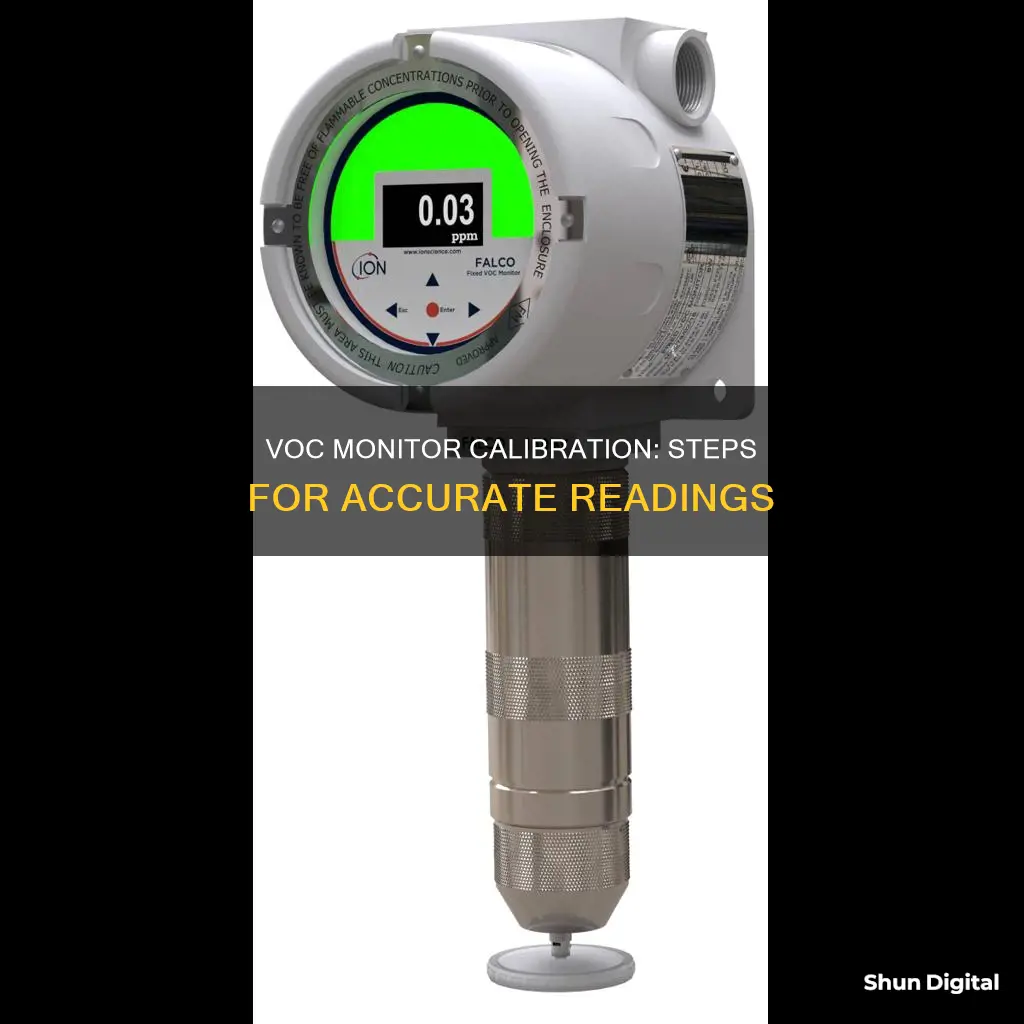
Calibrating a VOC monitor is a crucial process to ensure the accuracy and reliability of detection results. VOCs, or Volatile Organic Compounds, are widely used in various industrial fields but can be harmful to humans and the environment. This article will provide an overview of the steps and considerations involved in calibrating a VOC monitor, including the preparation of calibration gas, the calibration process, and the factors affecting the calibration cycle. Additionally, we will discuss the role of VOC sensors in ensuring safety and the importance of regular calibration to maintain accurate data support for VOC monitoring.
| Characteristics | Values |
|---|---|
| Calibration gas | High purity, certified to international standards |
| Calibration gas validity | Check expiry date |
| Calibration instrument status | Check VOC sensor, battery power, and appearance |
| Calibration process | Prepare gas, connect to instrument, start calibration, record results |
| Calibration cycle | Determined by testing instrument requirements and use environment characteristics |
| Calibration steps | Zeroing and adjusting |
| Calibration error | Recorded and calculated |
| Calibration period | Stability of detection instrument, changes in use environment, and regulation/standard requirements |
| Calibration curve | Updated on Aeroqual Cloud |
| Calibration run | Zero air, VOC gas, and zero air again |
| Calibration reading | Stable number, plus or minus 0.1 ppm |
| Calibration check | Quick check with span gas cylinder or full calibration |
What You'll Learn

Calibration gas purity and validity
Calibration gas is a key factor in calibrating VOC detection instruments. To ensure accurate calibration results, high-purity calibration gases must be used. Calibration gas suppliers should provide calibration gases certified to relevant international standards. The gas calibration standard should be characterised by mass and validated by the supplier using a laboratory chromatograph. The calibration gas composition should closely approximate the normal field composition.
The purity of calibration gas is essential for its accuracy and reliability. Calibration gas has a limited shelf life, typically ranging from 6 to 36 months, depending on the gas mixture and manufacturer. It should be stored properly, in a cool, dry place away from sunlight and heat sources, to maintain its integrity. The validity period of calibration gas should also be checked before use, as using expired gas will affect the accuracy of calibration results.
The "accuracy" of a calibration gas mixture is made up of two components: preparation tolerance and measurement uncertainty. Preparation tolerance refers to how closely the manufacturer can match the customer's requested values, while measurement uncertainty describes the accuracy of the tools used to measure the result. The best-quality gas mixtures are manufactured gravimetrically and then analysed with an accredited process.
In addition to checking the purity and validity of calibration gas, it is also important to confirm the status of the calibration instrument before performing calibration. This includes checking the normal operation of the VOC sensor, the battery power of the instrument, and the physical condition of the instrument.
Monitoring Portfolio Performance: Strategies for Success
You may want to see also

Calibration instrument status check
Confirming the status of the calibration instrument is a crucial step in preparing to calibrate a VOC monitor. This process involves checking several factors to ensure the instrument is in good working condition.
Firstly, the normal operation of the VOC sensor should be verified. This includes checking the sensor's ability to detect and analyse gases in the immediate atmosphere, as well as ensuring that the sensor is not malfunctioning due to resistance to environmental factors such as high humidity, extreme temperatures, dust, or vibrations.
Secondly, the battery power of the instrument should be inspected to ensure it is functioning optimally. This is important as insufficient power can affect the accuracy and reliability of the calibration results.
Additionally, the physical condition of the instrument should be assessed. This includes checking for any damage or tampering with the instrument's appearance or display. For example, the display of the instrument may have a series of magnetic switches surrounding it to prevent unauthorised personnel from making changes.
Furthermore, the calibration instrument's status may be displayed on the user interface screen, providing information about the calibration method and type. This can be a helpful indicator of the instrument's current settings and any adjustments that may be required.
By performing these checks, you can ensure that the calibration instrument is ready for the calibration process and that potential issues are identified and addressed beforehand.
Monitoring Globe Broadband Usage: A Step-by-Step Guide
You may want to see also

Calibration process
The calibration process for a VOC monitor involves several steps to ensure accuracy and reliability in detecting volatile organic compounds (VOCs). Here is a detailed guide on the calibration process:
- Prepare Calibration Gas: Select a calibration gas that meets the requirements of the detection instrument. This gas should have a well-defined concentration of a specific VOC or a gas mixture representative of TVOCs. Ensure the purity of the calibration gas by using high-purity gases certified to relevant international standards. Also, check the validity period of the calibration gas as it usually has an expiry date.
- Connect the Calibration Gas: Connect the calibration gas to the detection instrument, ensuring a smooth and sealed flow of gas to prevent leakage. This step involves using appropriate tubing and connectors to establish a secure connection.
- Start Calibration: Refer to the operating manual of the testing instrument for specific instructions. Calibration typically includes two steps: zeroing and adjusting. Zeroing resets the reading of the instrument to eliminate environmental interference. Adjusting involves matching the reading to the concentration of the calibration gas.
- Record Calibration Results: During and after calibration, record the readings and calculate the calibration error. This helps track the accuracy and reliability of the instrument and facilitates subsequent calibration adjustments.
- Determine Calibration Cycle: The calibration cycle refers to the time interval between calibrations. It is important to consider factors such as the stability of the detection instrument, changes in the use environment (e.g., temperature, humidity), and relevant regulations and standard requirements when determining the appropriate calibration cycle.
- Electrochemical Analysis: In the case of electrochemical sensors, safety engineers should check the computer chip inside the sensor to ensure proper analysis of the current passing through. This is crucial for accurately measuring dangerous levels of gases like hydrogen, methane, and carbon monoxide.
- Automatic Programming: VOC detectors rely on automatic programming to analyze the atmosphere and relay data to monitoring stations. By measuring gas density, the sensor can be calibrated to trigger automatic shutdowns and alarms when density levels reach dangerous thresholds.
- Multi-Step Calibration: To ensure safety and prevent contamination, employ a multi-step calibration process. This guarantees that safe gas levels are maintained, complying with government regulations designed to protect workers from hazardous compounds.
- Secure the Calibration Process: Most VOC sensors have magnetic switches surrounding the display to prevent unauthorized personnel from making changes. This feature enables quick configuration changes from remote locations, ensuring emergency workers receive accurate information during emergencies.
- Monitor Calibration Progress: During calibration, pay attention to the stability of readings. Depending on the sensor and your requirements, you may need to wait for a specific duration (e.g., 10 minutes) or until you observe stable readings for a shorter period (e.g., 3-4 minutes).
- Make Necessary Adjustments: If you are satisfied with the calibration reading, you can move on to the next step. If not, make the necessary adjustments as per the instructions in the operating manual. This may involve changing offsets or gains to align the sensor's response with the known concentration of the calibration gas.
- Final Checks: After completing the calibration, perform final checks by reviewing the calibration results and ensuring that the sensor functions optimally. This may include checking the zero reading again to ensure accuracy.
By following these steps, you can ensure that your VOC monitor is accurately calibrated and ready for deployment in strategic locations to detect VOCs effectively.
Monitoring Database Performance: Strategies for Success
You may want to see also

Electrochemical analysis
The outer shell of a VOC sensor is designed with numerous small holes, allowing the gas in the immediate atmosphere to penetrate the shell and be analysed by the sensor. This enables the detection of dangerous levels of hydrogen, methane, and carbon monoxide, requiring only a small amount of gas molecules. To ensure proper calibration, safety engineers inspect the computer chip inside the sensor to confirm that the current passing through can be accurately analysed.
The calibration process for a VOC sensor involves the following steps:
- Preparation: Ensure the purity and validity of the calibration gas, and check the status of the calibration instrument, including the VOC sensor's normal operation and battery power.
- Connect the calibration gas: Connect the calibration gas, such as isobutylene, to the detection instrument, ensuring a smooth flow without any leaks.
- Start calibration: Follow the specified steps in the operating manual, including zeroing and adjusting the instrument. Zeroing resets the reading to eliminate environmental interference, while adjusting involves matching the reading to the concentration of the calibration gas.
- Record calibration results: Document the readings before and after calibration and calculate the calibration error to track accuracy and conduct subsequent adjustments.
- Determine the calibration cycle: Consider factors such as the stability of the detection instrument, changes in the use environment, and relevant regulations to establish an appropriate calibration schedule.
Additionally, VOC sensors play a crucial role in monitoring the chemical makeup of the surrounding air. Through automatic programming, they can analyse the atmosphere and relay critical data to monitoring stations. This information is vital for triggering emergency protocols, such as automatically shutting down equipment and setting off alarms, to protect workers from hazardous compounds.
Explore the Best SQL Performance Monitoring Tools
You may want to see also

Automatic programming
A VOC (Volatile Organic Compounds) monitor needs to be regularly calibrated to ensure the accuracy and reliability of detection results. Calibration is a key step in ensuring the safety of human health and the environment, as VOCs are potentially harmful.
The automatic programming aspect of calibration involves the use of a VOC detector to analyze the atmosphere and relay the correct data to monitoring stations. This is done by measuring the density of gas in the air. The detector can then be calibrated to respond to certain density levels, triggering actions such as automatically shutting down equipment and setting off alarms to alert workers of potential danger.
To ensure proper calibration, a series of customized networks are put in place as detection points. This lowers the risk of workers being exposed to hazardous compounds. A multi-step calibration process is always followed to guarantee safe gas levels and comply with government regulations.
- Prepare calibration gas: Select a calibration gas that meets relevant international standards and has a well-defined concentration of a specific VOC. Ensure the gas flow rate, concentration, and other parameters match the requirements of the VOC monitor.
- Connect the calibration gas: Connect the calibration gas to the VOC monitor, ensuring a smooth flow of gas and preventing gas leakage.
- Start calibration: Refer to the operating manual of the VOC monitor for specific instructions. Calibration typically includes two steps: zeroing and adjusting. Zeroing resets the reading of the instrument to eliminate environmental interference. Adjusting involves matching the reading of the instrument to the concentration of the calibration gas.
- Record calibration results: Document the readings before and after calibration and calculate the calibration error. This helps track the accuracy and reliability of the VOC monitor and allows for subsequent calibration adjustments.
- Determine the calibration cycle: The calibration cycle refers to the time interval between calibrations. It is important to consider factors such as the stability of the VOC monitor and changes in the use environment to determine the appropriate calibration frequency.
- Connect gas cylinders: Physically connect the gas cylinders to the monitor, following the instructions provided by the manufacturer. Ensure that the connections are secure and tight to prevent gas leaks.
- Update software: Access the software or cloud platform associated with the VOC monitor. Update the calibration curve by entering the current readings and making any necessary adjustments.
- Run calibration tests: Conduct a series of tests using zero air and VOC gas at specific concentrations. Follow the instructions provided by the manufacturer for running these tests and interpreting the results.
- Adjust settings: Based on the calibration test results, adjust the settings on the VOC monitor, including sensitivity, gain, and offset. Make sure to follow the recommended guidelines and tolerances provided by the manufacturer.
- Finalize calibration: Once all the necessary adjustments have been made and the VOC monitor is reading accurately, finalize the calibration process by saving the new settings.
By following these steps and utilizing automatic programming, you can ensure that your VOC monitor is properly calibrated and providing accurate data for VOC monitoring. Regular calibration is essential to maintain the accuracy and reliability of VOC detection, protecting human health and the environment from the potential hazards of VOCs.
Monitoring Xbox Usage: Remote Control for Parents
You may want to see also







